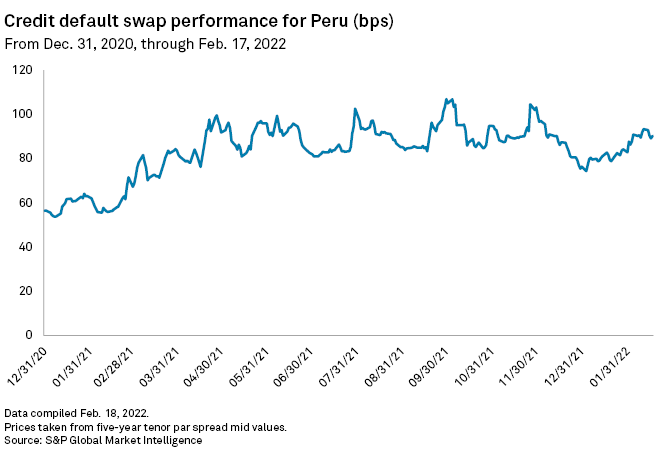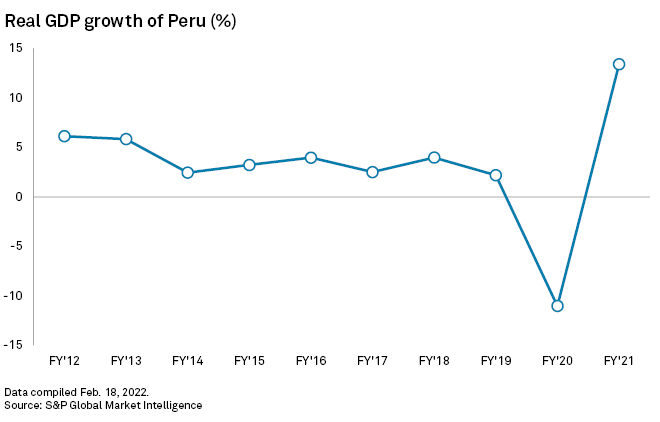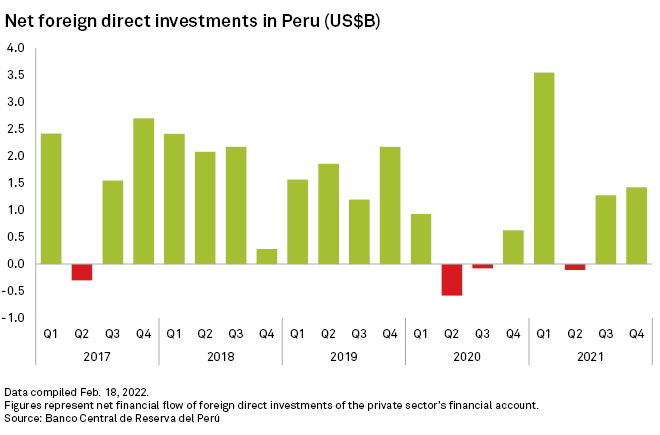Peru has cycled through five presidents over the past five years amid impeachments, imprisonment and even suicide. Nevertheless, the country has had the rare distinction of delivering economic growth even in the face of political mayhem.
Growth jumped a healthy 13.4% last year, one of the fastest rates in Latin America, largely driven by a pandemic stimulus that was one of the largest in the region, at about 9% of GDP.
Those days are over.
There had been hopes of some degree of political stability when former school teacher Pedro Castillo took office in July 2021, even if he did run on pledges to redraft the constitution, increase taxes and nationalize industries, all of which unsettled business confidence. Fast-forward to February, however, and the president has already been plunged into a crisis as he swears in his fourth cabinet in roughly six months.
Political instability has reached a new level in Peru, and analysts say the economic resilience that characterized Peru for the past decade is finally caving into uncertainty.
“It is the first time I have made a downward economic revision for political reasons,” Munir Jalil, an executive director with BTG Pactual, said in an interview. “Until now, economic growth in Peru [has] been tremendously resistant and decoupled from [the] political mess, but for the first time that impermeability has been broken.”
The revolving door of cabinet members reflects poor public policy, experts said, while government actions are undermining growth and fueling doubt over the country’s future. The government is also unlikely to provide the same level of stimulus measures to prop up the economy, sending GDP growth estimates for this year as low as 3%, the weakest since 2017.

Economic resiliency shattered
With Castillo’s repeated reshuffling, all that can be expected is further paralysis, Rodolfo Rojas, a partner at Peru’s Sequoia Political Advisory, said in an interview.
“On average, Castillo changes a cabinet member every two weeks,” Rojas said. “This cabinet is a patch to get out of the situation. Both the level of political legitimacy and governability are going to be very low.”
The political situation is finally bleeding into growth estimates, with lower expectations founded on grimmer prospects for corporate investments. Brazilian investment bank BTG Pactual expects a 3.6% growth rate this year and a 3.3% growth rate in 2023. S&P Global Ratings, which set the country on negative watch last October, expects 3% growth for 2022. It will be among the highest in the region but significantly below its potential.
That is the price to pay for political instability and a rhetoric that spooks investments, analysts said. Adding to the fragmented political environment is a high labor informality resulting from the pandemic that could hurt Peru’s medium-term growth prospects. This, along with a demand to improve public services requiring public spending, could lead to further erosion in its debt metrics.
“Something is not working,” Jalil said. “3.6% GDP growth is just too little for a country like Peru, and would have been above 4% absent of political factors.”
The political and social noise could send lead global investors elsewhere. Peru, the second largest copper producer after Chile, may see mining companies postponing investments that are vital to the economy. Castillo has repeatedly targeted the mining industry, including proposals to hike mining taxes and nationalize mines. Large mines have faced backlash from local communities, in some cases resulting in blockades and production paralysis.
The evidence is already clear: foreign direct investment started retreating after a strong first quarter in 2021, a trend that could continue well into 2022.
“Castillo can do a lot of damage to the solid economic foundations that made Peru a regional economic star in the last 20 years,” Rojas said. “His Chavista dream may be gone, but the ability to move back in terms of economics is still uncluttered.”

Lower corporate lending
The main risk for the banking sector remains low economic growth and employment, she said, but there is also the possibility of new legislation affecting banks negatively.
Corporate lending will grow thin should low investment levels persist, leading banks to depend further on consumer lending and mortgages, according to Cynthia Cohen Freue, a bank director with S&P Global Ratings.
Congress has already approved a law against “financial usury” that established caps on interest rates last year, a move that is expected to dent bank profitability.
Evidently the banking sector has become just as vulnerable to politics as other areas. “The financial system has a lower evaluation than it could have if we did not take into account the [political] situation,” Cohen Freue said.
The good news is that Peruvian banks have traditionally reported strong profitability — if weakened during the pandemic — and results are expected to recover gradually amid a scenario of higher inflation and rising interest rates, according to an S&P report.
“The results will continue to be positive thanks to the high monetary policy rates,” BTG’s Jalil said. “But the situation could be even better in the absence of political uncertainty.”







